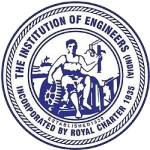Numerical Analysis of High Temperature Low Sag Conductor
Abstract
The conductors that can embrace high temperature low sag characteristics are known as HTLS conductors. The coefficient of thermal expansion of High temperature low sag conductor is lesser than that of conventional conductors. This thereby result in reduced sag with high rating. Among some HTLS conductor accessible, the Aluminium Conductor Composite Core (ACCC) conductor has light weight inner composite core. The geometric model of ACCC/TW conductor is modelled and analyzed using finite element analysis. The ACC/TW conductor is composed of inner composite core surrounded by two aluminium layers wound in clockwise and anti-clock wise direction. The inner composite core is made of glass carbon composite material. The core is surround by first layer consisting of 8 individual strands wound in clockwise direction. The second layer consisting of 14 individual aluminium strands wound in anticlockwise direction. In this paper, the individual core and assembled conductor is analyzed using FEA software to predict the behavior under loading conditions. The attained outcomes are validated with the experimental work reported in the literature.
Downloads
References
I. Albizu, A. J. Mazón, and I. Zamora, “Methods for increasing the rating of overhead lines,” 2005 IEEE Russ. Power Tech, PowerTech, no. November, 2005.
M. T. Bedialauneta, I. Albizu, and E. Fernandez, “Uncertainties in the Testing of the Coefficient of Thermal Expansion of Overhead Conductors,” energies, vol. 13,411, pp. 1–13, 2020.
E. Mateescu, D. Marginean, G. Florea, S. I. A. Gal, and C. Matea, “Reconductoring using HTLS conductors. Case study for a 220 kV double circuit transmission LINE in Romania,” Proc. IEEE Int. Conf. Transm. Distrib. Constr. Live Line Maintenance, ESMO, no. August, 2011.
D. G. Havard et al., “AGED ACSR conductors part I - Testing procedures for conductors and line items,” IEEE Trans. Power Deliv., vol. 7, no. 2, pp. 581–587, 1992.
V. T. Morgan, B. Zhang, and R. D. Findlay, “Effects of temperature and tensile stress on the magnetic properties of a steel core from an ACSR conductor,” IEEE Power Eng. Rev., vol. 16, no. 10, p. 62, 1996.
B. Burks, D. Armentrout, and M. Kumosa, “Characterization of the fatigue properties of a hybrid composite utilized in high voltage electric transmission,” Compos. Part A Appl. Sci. Manuf., vol. 42, no. 9, pp. 1138–1147, 2011.
E. J. Bosze, A. Alawar, O. Bertschger, Y. I. Tsai, and S. R. Nutt, “High-temperature strength and storage modulus in unidirectional hybrid composites,” Compos. Sci. Technol., vol. 66, no. 13, pp. 1963–1969, 2006.
W. G. Jiang, M. S. Yao, and J. M. Walton, “A concise finite element model for simple straight wire rope strand,” Int. J. Mech. Sci., vol. 41, no. 2, pp. 143–161, 1999.
J. Wang, “Overhead transmission line vibration and galloping,” 2008 Int. Conf. High Volt. Eng. Appl. ICHVE 2008, pp. 120–123, 2008.
H. Zangl, T. Bretterklieber, and G. Brasseur, “A feasibility study on autonomous online condition monitoring of high-voltage overhead power lines,” IEEE Trans. Instrum. Meas., vol. 58, no. 5, pp. 1789–1796, 2009.
K. Kopsidas and S. M. Rowland, “Evaluation of potentially effective ways for increasing power capacity of existing overhead lines,” 1st Int. Conf. Sustain. Power Gener. Supply, SUPERGEN ’09, 2009.
A. A. Alawar, E. J. Bosze, and S. R. Nutt, “High temperature strength and creep of an Al conductor with a hybrid composite core,” ICCM Int. Conf. Compos. Mater., no. January, 2007.
K. Kopsidas and S. M. Rowland, “A performance analysis of reconductoring an overhead line structure,” IEEE Trans. Power Deliv., vol. 24, no. 4, pp. 2248–2256, 2009.
E. Mateescu, D. Marginean, G. Gheorghita, E. Dragan, S. I. A. Gal, and C. Matea, “Uprating a 220 kV double circuit transmission LINE in Romania; study of the possible solutions, technical and economic comparison,” 2009 IEEE Bucharest PowerTech Innov. Ideas Towar. Electr. Grid Futur., pp. 1–7, 2009.
A. A. P. Da Silva and J. M. De Barros Bezerra, “A model for uprating transmission lines by using HTLS conductors,” IEEE Trans. Power Deliv., vol. 26, no. 4, pp. 2180–2188, 2011.
I. Albizu, E. Fernández, A. J. Mazón, M. Bedialauneta, and K. Sagastabeitia, “Overhead conductor monitoring system for the evaluation of the low sag behavior,” 2011 IEEE PES Trondheim PowerTech Power Technol. a Sustain. Soc. POWERTECH 2011, pp. 1–6, 2011.
A. Alawar, E. J. Bosze, and S. R. Nutt, “A composite core conductor for low sag at high temperatures,” IEEE Trans. Power Deliv., vol. 20, no. 3, pp. 2193–2199, 2005.
K. Qiao, A. Zhu, B. Wang, C. Di, J. Yu, and B. Zhu, “Characteristics of heat resistant aluminum alloy composite core conductor used in overhead power transmission lines,” Materials (Basel)., vol. 13, no. 7, pp. 1–13, 2020.
W. G. Jiang, J. L. Henshall, and J. M. Walton, “Concise finite element model for three-layered straight wire rope strand,” Int. J. Mech. Sci., vol. 42, no. 1, pp. 63–86, 2000.
B. K. Gnanavel and N. S. Parthasarathy, “Effect of interfacial contact forces in single layer cable assemblies,” Int. J. Mech. Mater. Des., vol. 8, no. 2, pp. 183–195, 2012.
B. K. Gnanavel, D. Gopinath, and N. S. Parthasarathy, “Effect of friction on coupled contact in a twisted wire cable,” J. Appl. Mech. Trans. ASME, vol. 77, no. 2, pp. 1–6, 2010.
B. K. Gnanavel and N. S. Parthasarathy, “Effect of interfacial contact forces in radial contact wire strand,” Arch. Appl. Mech., vol. 81, no. 3, pp. 303–317, 2011.
B. K. Gnanavel and N. S. Parthasarathy, “Effect of interfacial contact forces in lateral contact wire strand,” Proc. World Congr. Eng. 2011, WCE 2011, vol. 3, pp. 2057–2063, 2011.
Copyright (c) 2021 Boopathy S, Gnanavel BK, Radhika Karnal

This work is licensed under a Creative Commons Attribution 4.0 International License.
I/We agree with the provision of the Bye-Law 118 of The Institution of Engineers (India) which states that copyright of each paper published in Institution Journal or Annual Technical Volume in full or in Abstract at its centres shall lie with the Institution.

